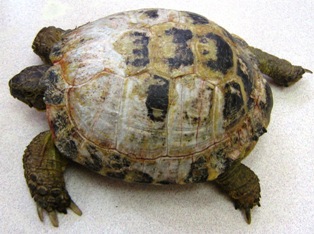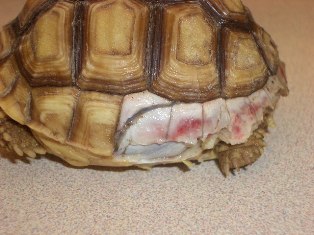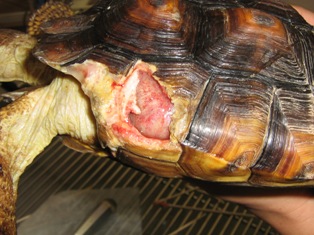Dog Bite Wounds in Turtles and Tortoises
 A sad fact is that dogs and tortoises are not a predictable mix. The family dog that has never hurt a fly often becomes overwhelmed with an irresistible urge to chew on the tortoise. Even dogs that have lived peaceably with tortoises for years have these lapses in decorum. Make sure that any interactions between your dog and your tortoise are closely supervised and make sure the tortoise is too large to be swallowed! Better yet, keep your tortoises in a dog-proof enclosure!
A sad fact is that dogs and tortoises are not a predictable mix. The family dog that has never hurt a fly often becomes overwhelmed with an irresistible urge to chew on the tortoise. Even dogs that have lived peaceably with tortoises for years have these lapses in decorum. Make sure that any interactions between your dog and your tortoise are closely supervised and make sure the tortoise is too large to be swallowed! Better yet, keep your tortoises in a dog-proof enclosure!
If such an injury occurs, your tortoise will need veterinary care. If you cannot get to us or an emergency clinic right away, please gently clean the wound with a warm wash cloth. If you have povidone iodine (e.g., Betadine™), you may use lukewarm water to dilute it to the color of weak iced tea and gently wash the wound. You may place Telfa™ pads over the wound and hold the pad in place with duct tape but do not completely cover the pads with tape as the wound needs to breathe. Do not put any ointments on or into the wound. Get to a veterinarian as soon as you are able.
There are four basic classes of dog bite injuries. A Class 1 injury, such as pictured at the top of this article, damages the scutes on the carpace or plastron and may have minor abrasions on the legs or other exposed skin. A Class 2 injury (illustrated below) means that the scutes are damaged and the bone beneath appears cracked or pitted but the underlying coelomic membrane that protects the internal organs has not been breached. A Class 3 injury (illustrated below) indicates that the coelomic membrane has been punctured and bacteria and foreign debris have entered the body cavity and contaminated internal organs. A Class 4 injury is reserved for those tortoises with grave injuries where internal organs have been damaged or are everted out of the shell wound. The treatment will vary depending on the exact nature of the injury but general involve pain relievers and anti-inflammatories, antibiotics, and bandaging. With proper care, almost all tortoises survive Class 1 and 2 injuries and the majority survive Class 3 injuries. However, the outlook for Class 4 injuries is poor and at a minimum requires several days of intensive care if the tortoise is to have a chance. Class 1 and 2 injuries should be brought to a veterinarian within 24 hrs of the occurence while Class 3 and 4 injuries require immediate veterinary care.
Spare yourself the heartache. Enjoy your tortoise and enjoy your dog but keep them separate!

Class 1 Injury. This Russian tortoise has only had a few small pieces of its scutes removed, unlike the unfortunate one at the top of the article.

Class 2 Injury. A young sulcata tortoise with a cracked carapace.

Class 3 Injury. A desert tortoise with its internal organs visible.



